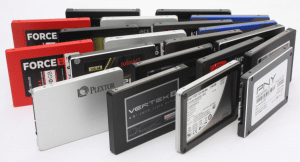
As always, links were active at time of publication.
- Storage Media and Technology
- Storage Companies in the News
- Industry Associations and Standards
- Webinars, Podcasts, and Conferences
- Synology News
- Bonus Round
Storage Media and Technology
Everspin is evidently making Spin Torque MRAM (STT-MRAM) for industrial and IOT applications. In short, this is a technology that is as fast (or very close to it) as DRAM, but is persistent (DRAM is volatile). By placing this technology in industrial and IOT use cases, there should be a pretty big bonus for retaining data in the case of power loss. From a bigger picture perspective, though, it raises some pretty interesting future possibilities with computational storage, IMO.
This… is interesting. GigaIO has announced a PCIe network that runs NVMe… over Fabrics. The reason why this is curious to me is that NVMe is PCIe-native (generally speaking), and despite what they claim in their white paper, FabreX (their fabric implementation of PCIe) is not a standardized transport technology for NVMe-oF. I would spend the time trying to understand what they’re trying to do, but any time a company munges (that’s a technical term) technologies that already exist and have clearly defined rules, I generally don’t have high hopes.
PC Mag has published it’s most recent Best Internal SSDs for 2020 article.
This is a really good article on What is a Hard Disk cache. When you look for hard drives on Amazon, for instance, they always talk about the size of their cache. Sadly, most people don’t know what that means. This article is long overdue, IMO.
Speaking of HDDs, there are a few ways and tools to determine if they’re failing. In my “copious free time,” I’m going to see if I can write my own article about this too.
And yet, there is an interesting take about whether or not SSDs and NAS is a worthwhile endeavor. (time sensitive)
NetworkWorld tries to pull a Gartner-like timing of talking about a technology that was old 3 years ago, pushing for Hyperconverged Infrastructure (HCI) in the Data Center. You would think that after all this time, he would have identified the potential well-known issues with HCI, including scaling, network performance, and failure domains. But noooOOOOooo…

If you’re a member of PCI-SIG (I’m not), I bet you can’t wait to get your hands on the PCIe 6.0 Spec…
ArchitectingIT has a very interesting article on the benefits of, effectively, crowd-sourced storage platforms, as often seen in OpenSource Software (OSS) environments. I really like his assessment, here, and agree with much of his spirit and intent.
Western Digital adds enterprise SSDs to the Gold brand, which had been for HDDs only. As you can see, the addition of SSD media to the HDD line implies a change in the performance category of the Gold line, so the question becomes how this will change customers’ buying behavior.
Speaking of SSDs, ZDNet writes about a paper jointly written by NetApp and researchers at the University of Toronto about the Reliability of SSDs in Large Scale Enterprise Storage Deployments. He notes that there are a few surprises to be found.
Flackbox has a pretty good 10-minute tutorial on iSCSI.
Enrico Signoretti has a really good blog article on the Status of Object Storage. He talks a bit about the different players and their approaches, which is quite useful.
NetworkWorld has been really hit or miss lately; this article is a strange combination of both. Even though it’s an obvious (but undisclosed) advertisement for Western Digital, there are some good insights about the impacts of heat and vibration on HDDs.
Ceph has apparently been made to run faster, scale out to 1B+ objects, and added more automation.

Storage Companies in the News
You may be familiar with Storage Switzerland, the analyst firm started by George Crump. He’s decided to join StorONE as the CMO. Congrats to George!
Mellanox, which is in the process of being acquired by Nvidia, is going to acquire Titan IC (who makes network intelligence and security technology for analytics). One of these days I’m going to take some time to try to view the bigger picture about this…
Vast Data has gained a customer with a “major US telco” to create a storage platform for massive Splunk data ingestion. If there was a bullseye for the kind of use case that Vast shines in, this would be it.
Coldago Research has apparently published its (paid) report about “Storage Unicorns.” It has to do with companies that have reached the precious $1B valuation mark. The report is almost $1000, but I have to confess I’m really curious as to why they put Barracuda and Kaseya on that list. (This link goes to StorageNewsletter, which has a time-sensitivity for its articles).
StorageNewsletter also broke the news that KMesh “silently” was acquired by AWS. In a nutshell, KMesh provides Lustre integration for AWS that includes auto-provisioning, data tiering, deduplication, multi-cloud snapshots, and virtual copies. Get this article while it’s hot.
BackupInfo has a list of the Top 25 Cloud Data Backup “Enablers” and Top 100 Cloud Backup Companies for March 2020. In other news, there are enough Cloud backup companies to have a “top 100” list.
So, Western Digital hired Dave Goeckeler, former EVP (and my ex great grandboss at one time) to take on the CEO and a Member of the Board of Directors roles over there. See, this is interesting, because to go from running the networking, compute, and security business at Cisco to running commodity storage is bizarre to me. He had absolutely no interest in storage at Cisco, so I’m truly, utterly amazed by this. The Motley Fool has their own assessment of his 4 biggest challenges, too.
Nvidia is buying Swiftstack, and in looking through this it appears I have been remiss in paying attention to what SwiftStack was doing. Looks like I have some upkeeping to do on my education there.
Not dead yet! Quanta Storage has asked the Fifth Circuit to throw out HP Inc’s $438.7 million win in a price-fixing case. (article behind paywall).
Recently I was asked just how much interest there was in NVMe-oF in terms of turning the technology into practical products. So, this could probably have gone up into “Storage Technology,” but since it’s a showcase by Micron and LightBits, I’ve decided to put it here (as it’s most definitely highlighting two companies’ products). Nevertheless, this is a true, old-school kind of blog (the kind that I used to be able to write in the early days of working for Cisco), so I thoroughly appreciate the work that went into this to make it “just the facts, ma’am.” So, if you are interested in NVMe/TCP performance information and a Proof of Concept, Micron and Lightbits have run a series of tests that is well worth a read.
NetApp is really pushing into this Cloud-first approach. They’ve just announced that they will acquire Talon Storage, who do “software-defined storage services” for the Enterprise.
Vast Data has been certified by Cohesity for support delivery. This is really good news for Vast Data, and it’s a great validation of QLC media for real-world backup and data management.
Industry Associations and Standards

SNIA has released several documents for public review:
- SNIA TLS [Transport Layer Security] Specification for Storage Systems, v. 1.01
- Native NVMe-oF™ Drive Specification v1.0p [Also known as “Ethernet-SSDs”]
- Computational Storage Architecture and Programming Model v0.3 rev 1
- SNIA Emerald™ Power Efficiency Measurement Specification v4 draft 22
Webinars, Podcasts and Conferences
First things first – many of the conferences have been cancelled or postponed. I don’t know if this ZDNet article is being updated regularly, but as of right now it’s an excellent source of what has been cancelled.
To that end, there has been a move to more “virtual” events thanks to the Coronavirus. I was asked to join The Cube with John Furrier to talk about creating of social groups and affiliation to those groups through the use of digital technology. As it just so happens, this was the topic of my doctoral dissertation in the early 90s, where we were asking the same questions. It was a lot of fun to dust off that old skill set and talk about it, as it addresses some of the concerns that people are having about the changing nature of relationships in a purely digital realm.
[youtube=”https://www.youtube.com/watch?v=F2GylXk1-Jo”]
Speaking of the NSF, there is going to be a webinar on “The Potential Impact of QUIC – Will it Replace TCP/IP?” If you’ve never heard of QUIC, it’s an interesting technology that has come out of Google that is already in use in many of their technologies, including their Chrome browser. Personally, I’m really looking forward to seeing this one. It will be on April 2.
Storage Unpacked has a podcast on Google Anthos and their storage partners. As I have no idea what this is about, I’m looking forward to listening.
The SNIA Call for speakers is now open for the Storage Developer Conference (SDC) in September in Santa Clara. The call for speakers for SNIA India closes on March 31, so that deadline is approaching fast.
Sadly, the Coronavirus has had an impact on a lot of the Spring conferences. NetApp, for instance, has postponed the Insight event in Paris and Berlin.
You don’t need to travel to listen to a podcast, though, but sometimes it helps (I always listen to podcasts while driving, for instance). I’ve been talking about Computational Storage more and more lately, but you really need to hear the podcast with Scott Shadley and Nick Adams to get a true insider’s view.
I mentioned that the 1.0p spec of the NVMe-oF™ Drive is now out for public review. Coming up on March 17, you can find out some more about what this means with the SNIA NSF webinar on Ethernet-Attached SSDs – Brilliant Idea or Storage Silliness?
A bit of a change of gears, but there’s also a webinar coming up on April 1 (yeah, I know) on The Impact of Artificial Intelligence on Storage and IT. I’m not part of this webinar, but I really hope that it goes into some comparison of the nature of storage and IT as it exists in a non-AI environment first, so that there is a clear understanding of just how much AI has impacted the way we think of storage networks, architecture, and data I/O. But, that’s just me.
As far as something that I have been part of (though won’t be involved in this particular webinar), the SNIA Storage Security series continues with Protecting Data at Rest. Yes, encryption is a part of protecting your data at rest (that will be another, dedicated webinar sometime in May), but protecting your data at rest is far, far more involved than simply scrambling the information. This is a very worthwhile webinar to watch willingly with wide-eyed wonder.
The SNIA Technical Symposium will be held in Fremont, CA, from April 20-24, 2020. All the sessions for non-Board Members (that’s almost everyone) will be held Monday-Wednesday of that week, though.
Synology News
Coolest Gadgets has a review of the best (home) NAS devices, which lists the Synology 2 bay NAS Diskstation DS218+ as their favorite. Having had multiple 2-series (the last two digits, “18” are the year that the model came out) Synology Diskstations, I can say that I cannot agree with this assessment. For some reason, there is an ongoing problem with this series related to uptime and power management. Every single one of them has had the blue blinking light (fortunately, none of mine were “of death,” but they did require a very long restart and POST processes). Underscores the need for a good backup plan.
Please see earlier Storage Short Takes for additional Synology advisories. Some of those vulnerabilities are still active.
Important Severity
Affected: DSM and/or SRM
Status: Ongoing
Solution: If you need immediate assistance, please contact Synology technical support via https://account.synology.com/support.
Details:
A vulnerability allows remote attackers to execute arbitrary code via a susceptible version of DiskStation Manager (DSM) or Synology Router Manager (SRM).
References
Moderate Severity
Affected: Samba.
Status: Ongoing
Solution: None.
Detail:
Multiple vulnerabilities allow remote authenticated users to bypass security constraints via a susceptible version of Synology Directory Server or allow remote attackers to conduct denial-of-service attacks via a susceptible version of DiskStation Manager (DSM) or Synology Router Manager (SRM).
None of Synology products are affected by CVE-2019-19344 as the vulnerability only affects Samba 4.9 and later.
Affected: Synology Assistant.
Status: Resolved.
Solution: Upgrade to 6.2.2-24922 or above.
Detail:
A vulnerability allows remote attackers to conduct denial-of-service attacks via a susceptible version of Synology Assistant..
Bonus Round
Solutions Review has a list of the best Cloud Storage Books you need to read in 2020, and there are some really good choices in there. Unfortunately, there are also some really old choices in there as well. Not quite ‘2020’-specific. There should have been at least this one by Greg Schulz on understanding Storage I/O Tradecraft.
Please, please, please read Drew Conry-Murray’s article on Surveillance As A Service – Whether You Opted In Or Not. He shares my concerns about our non-inconsequential sacrifice of privacy, and it’s well-worth a read. Then read The Register’s take on how all of the US telcos have been selling our information willy-nilly, and start to piece together the bigger picture.

